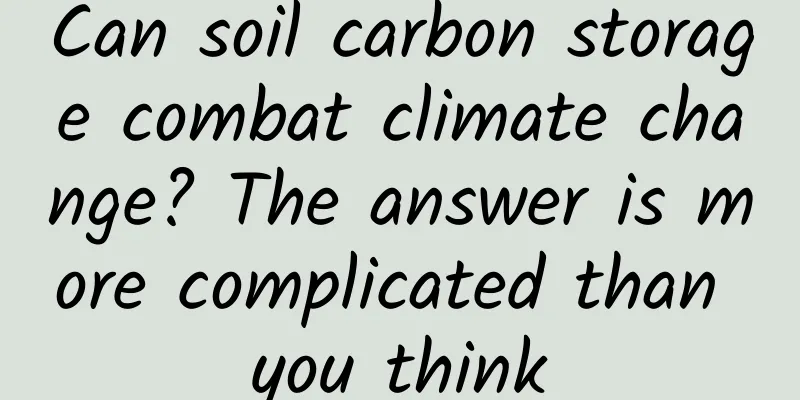Can soil carbon storage combat climate change? The answer is more complicated than you think

|
Plants convert carbon dioxide into roots, stems, and leaves through photosynthesis. The fallen branches and leaves and root products are buried in the soil and converted into soil organic matter. This is the traditional soil carbon sink. In simple terms, soil can absorb, convert, and store carbon dioxide from the atmosphere through plants. However, recent studies have shown that the truth may not be that simple. This has to start with the complex composition of soil. A teaspoon of healthy soil contains more bacteria, fungi and other microorganisms than humans on Earth. Soil humus has always been considered to be a type of complex and stable macromolecular organic matter formed during the humification process of organic materials, with the emphasis on the word "stable". However, recent studies[1] have shown that “current evidence does not support the formation of large, persistent ‘humus’ in soils.” Over the past decade or so, most soil scientists have come to accept this view. Yes, soils vary widely and contain a lot of carbon. But this carbon is not stored away forever, unbroken. "The properties and characteristics of soil, the stuff that's in the textbooks, the theory of soil organic carbon accumulation has been proven to be mostly wrong ... but we still stick to it," said Greg Sanford, a soil researcher at the University of Wisconsin-Madison. This will not only lead to more considerations for soil-based nature-based solutions, but will also cause serious deviations in previous climate models. Studies have shown that soil carbon storage capacity is highly sensitive to temperature changes, which has a significant impact on important carbon pools such as tropical rainforests [2]. In addition, the carbon sequestration and emission reduction potential of agriculture also needs to be considered. Soil organic carbon pool accounts for about 2/3 of the entire terrestrial ecosystem, about 3 times the plant carbon pool and 2 times the atmospheric carbon pool. According to the data in the Second National Assessment Report on Climate Change, the reserves of China's soil carbon pool are about 102.96 billion tons. If the carbon credit calculation based on this data is wrong, the time we have to mitigate climate change may be much shorter than we think. In terms of agriculture, the 2015 United Nations Paris Climate Change Conference proposed the "4/1000" initiative, which aims to increase the organic carbon storage of global agricultural soils by an average of 4/1000 per year. The European Union and other countries have also issued sustainable agriculture bills, hoping to accelerate the natural carbon sequestration process from the soil. In addition to soil degradation, compaction, acidification, salinization, nutrient imbalance, erosion and other problems, we also need to consider in detail the impact of agriculture on soil carbon storage capacity. In recent years, soil science researchers have been studying how to really and continuously fix carbon in the soil. Salk's team proposed the idea of using plants rich in suberin to fix carbon in the soil. In April 2021, the United States proposed paying farmers to grow cover crops to nourish the soil. (There is evidence that when the roots of cover crops decompose, some of their carbon remains in the soil.) However, whether these practices are really effective will take time to consider. (Content reference: https://advances.sciencemag.org/content/7/21/eabd1343) Text/Stan Review/YJ [1] Lehmann, J., Kleber, M. The contentious nature of soil organic matter. Nature 528, 60–68 (2015). https://doi.org/10.1038/nature16069 [2] Nottingham, AT, Meir, P., Velasquez, E. et al. Soil carbon loss by experimental warming in a tropical forest. Nature 584, 234–237 (2020). https://doi.org/10.1038/s41586-020-2566-4 |
Recommend
How can B-side new media operations improve writing skills?
After I shared my annual thoughts on B-side new m...
Baidu promotes information flow advertising AR display style!
Information flow advertising style - AR style Sog...
Why does a cherry-flavored drink taste like almonds?
If you have ever tasted those "cherry-flavor...
Today is the beginning of the dog days. Why do the dog days sometimes last 30 days and sometimes 40 days?
"It is the dog days of summer, and the weath...
How to make users addicted to your product?
Why do users keep using some products (including ...
Douyin mini-game blue ocean project, earning 5000+ a day without fans
The 15th strategy of the three crazy demolishers ...
How to break through the boundaries of electricity application in the construction of space solar power stations?
What is a space solar power station? Why do we ne...
AARRR model of user growth!
User growth is essentially a precise, low-cost an...
Ideas + steps + methods, three steps to teach you how to quickly build user portraits?
If you are walking on the street and see a person...
How to keep your programmers from getting bored with their work?
As a programmer, I never worked for the same comp...
The cleaner these 5 parts of your body are, the longer you may live!
45 years old is also called pre-senile The earlie...
The offer of buying a roast chicken for 99 yuan and getting a free trip has been suspended (with original text)
The 99-yuan roast chicken gift with free travel o...
Operation system [Introduction]: How to do promotion and marketing?
Today I will talk about three points: 1. Third-pa...
Methods and strategies for generating private domain traffic from 0 to 1!
Based on his own work experience and combined wit...
The "Exploration No. 1", which once caught lionfish and hook shrimp in the deep sea of 10,000 meters, has completed a new mission
On the afternoon of January 26, the "Explora...









